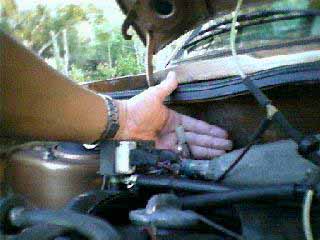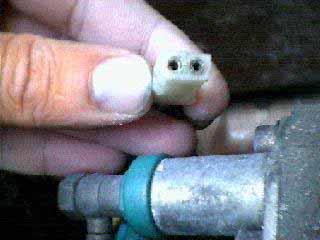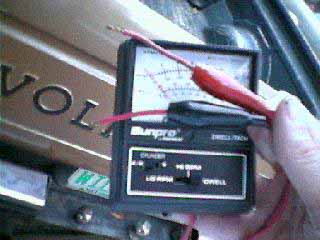| One of the reasons I love
the Rabbit so much is because of it's easy to diagnose and work on, and
relatively CHEAP, Fuel Injection system, The Bosch (Mechanical) CIS.
Check for Vacuum Leaks: Before you do ANY tweaking of the CIS, check for vacuum leaks. Vacuum leaks can come in many forms and is VERY detrimental to your bunny's health. Vacuum leaks can come in many forms.
Shadetree Timing: After all of your vacuum leaks are nipped in the bud, you can move on to timing. Timing is easy. For those who know how to time, I'll humor you with the no-proper-tools-available way. For those who don't know what timing a car is about, I'll let you read this first, but then I recommend you proceed to the "go to Auto Zone and buy a timing light for $50" way. All of your VWs have marks on the rotating parts to denote 0° TDC. The cam has a dot that lines up with the valve cover. The flywheel has a notch that lines up with the center of the hole on top of the bell housing. The distributor has a slash that lines up with the rotor. Line all of these up and your car is at 0. No advance. No retard. In a pinch, I've put the car
in 5th gear (with the car off!) loosened the distributor and pulled the
car forward until the advance mark on the flywheel appeared in the little
timing hole. I then turned the distributor until the hash mark lined up
with the rotor and tightened her down. If your flywheel notch is at 3°
or 5° or whatever, now your distributor is at 3° or 5°. It's
probably good for keeps or at least until you can get your hands on a timing
light, but it DOES work accurately!
Ensure proper system pressure: You'll need to muster up some
pieces for this, but this is a handy tool to make to have around. A VW
fuel pressure gauge. I've worked hard on this
fuel pressure segment that shows how to make a fuel pressure gauge
and how to read it. Using the pressure gauge you can determine if your
pump is good, your control pressure regulator is clogged and more.
Checking the Air/Fuel Ratio: For this you will need to locate
your "lambda" test port and you'll need to buy a dwell meter. Below, you
see where I've located the lambda test port on an '82 Rabbit. US Rabbits
have the lambda test port behind the cold start injector. A Scirocco will
have it on the other side of the intake manifold, just to the right of
the coil.
A closer look reveals the size
and shape of the test port.....
On my cheapo analog dwell meter
(which is all I need, since this is the ONLY thing I use a dwell meter
for nowadays) I have clamped two wires that are just the right gauge to
fit inside the receptacles on the test port. Red into blue wire on test
port (positive) and black into the black wire (negative). I set the dwell
meter to 4 cylinder and crank the car up.
With your dwell meter plugged in and the car idling, you will see the needle on the meter bounce. An idle location for the needle to bounce between is 40 and 50. If the "bounce" is too low, say between 30-40 or lower, then your bunny is too rich. If the "bounce" is too high, say between 50-60 or higher, then your bunny is to lean. If the needle bounce covers a range greater than 10 (say a bounce between 25 and 40) then you have issues elsewhere. Check all of the above issues (pump, vacuum leak, etc.) If your bunny seems to be too
rich or too lean AND ALL OTHER THINGS ARE TAKEN INTO CONSIDERATION (pump,
filter, vacuum leak, etc.) then (and only then) you can adjust the above
readings with your 3MM hex wrench. Located between your fuel distributor
and your flow plate on the lid of your air box is a hole. The hole is 4MM
in diameter. This hole may be plugged. If so, find the plug and screw in
a very small sheet metal type screw and pull the plug out. Beneath this
hole (where you can not see) is a 3MM set screw that will adjust your mixture.
Turning this screw clockwise will make the mixture richer, while turning
the screw counterclockwise will make the mixture leaner. I recommend turning
the screw by half a turn at a time, removing the screw, accelerate the
engine and checking your dwell meter. Repeat as necessary. Once the dwell
is hovering in the ideal range, adjust the idle accordingly (if necessary)
with the 7MM "bolt" located on the backside of the throttle body and check
the dwell again. Repeat if necessary.
|


